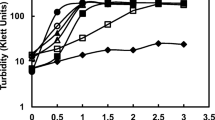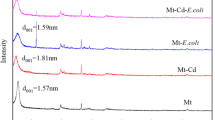Abstract
The resistance to divalent metal ions, antibiotics and H2O2 was investigated inYersinia kristensenii strains 13, 15, 18 by performing subcultivations with CdSO4 (20 and 100mg/L) in nutrient agar (NA) and M9 medium with thiamine. Metal resistance of all three strains in NA was the same and decreased in the following sequence: Ni>Zn=Co>Cd. The chloramphenicol (Cmp) resistance ranged between 32 and 256 mg/L and the H2O2 sensitivity was very low or even zero. In the presence of thiamine the metal resistance sequence changed to Zn=Cd>Ni, Co, Ni and Co tolerance being 10–20 mg/L. Cmp resistance of all strains increased to 256 mg/L and H2O2 sensitivity also rose. In Cd-treated cultures, the ratio of glucose to thiamine in culture medium affected Cd resistance. At normal content of glucose and thiamine (5 g/L and 5mg/L), Cd resistance markedly decreased coincident with thiamine exhaustion in these slowly-growing cultures. The Cmp resistance decreased to 16 mg/L, Ni and Co intolerance and H2O2 hypersensitivity appeared. At lowered glucose or thiamine levels (5 g/L and 2.5 mg/L or 2.5 g/L and 5 mg/L) a marginal decrease of Cd resistance took place in response to limited glucose uptake. Low thiamine or low-glucose cultures were resistant to H2O2, and exhibited a small decrease in Cmp resistance and a low Ni, Co tolerance. The adaptation of strain 15 to Cd induced only a small decrease of Cd resistance. Lowered glucose-to-thiamine ratio in culture medium probably induced in Cd-treated cultures a response triggering Cd resistance.
Similar content being viewed by others
References
Asad N.R., Leitao A.C.: Effects of metal ion on DNA strand breaks and inactivation produced by hydrogen peroxide inE. coli: Detection of iron-independent lesions.J. Bacteriol.173, 2562–2568 (1991).
Beard S.J., Huges M.N., Poole R.K.: Inhibition of the cytochromebd-terminated NADH oxidase system inE. coli K12 by divalent metal cations.FEMS Microbiol. Lett.131, 205–210 (1995).
Bercovier H., Ursing J., Brenner D.J., Steigerwalt A.G., Fanning G.R., Carter G.P., Mollaret H.H.:Yersinia kristensenii: a new species ofEnterobacteriaceae composed of sucrose-negative strains (formerly called atypicalYersinia enterocolitica orYersinia enterocolitica-like).Curr. Microbiol.4, 219–224 (1980).
Buchanan R.L., Edelson S.G.: Culturing enterohemorrhagicE. coli in the presence and absence of glucose as a simple means of evaluating the acid tolerance of stationary-phase cells.Appl. Environ. Microbiol.62, 4009–4013 (1996).
Bucheder F., Broda E.: Energy-dependent zinc transport byE. coli.Eur. J. Biochem.45, 555–559 (1974).
Cohen I., Bitan R., Nitzan Y.: The effect of zinc and cadmium ions onE. coli B.Microbios68, 276–277 (1991).
Fitt P.S., Sharma N.: Starvation as an inducer of error-free DNA repair inE. coli.Mutat. Res.262, 145–150 (1991).
Gadd G.M.: Metal and microorganisms: a problem of definition.FEMS Microbiol. Lett.100, 197–204 (1992).
Goldman J.: Conceptual role for microaggregates inpelagic waters.Bull. Marine Sci.35, 462–467 (1984).
Halliwel B., Gutterridge J.M.C.: Biologically relevant metal ion-dependent hydroxyl radical generation: an update.FEBS Lett.307, 108–112 (1992).
Kogoma T., Yura T.: Sensitization ofE. coli cells to oxidative stress by deletion ofrpoH gene, which encodes the heat shock sigma factor.J. Bacteriol.174, 630–632 (1992).
LaRossa R.A., Smulski D.R., Van-Dyk T.K.: Interaction of lead nitrate and cadmium chloride withE. coli K12 andS. typhimurium global regulatory mutants.J. Ind. Microbiol.14, 252–258 (1995).
Miller J.H.:Experiments in Molecular Genetics. Cold Spring Harbor Laboratory, Cold Spring Harbor (NY) 1972.
Matin A.: Physiology, molecular biology and application of the starvation response.J. Appl. Bacteriol.73, 49S-57S (1992).
Matin A.: Role of alternate sigma factors in starvation protein synthesis—novel mechanisms of catabolite repression.14th Forum in Microbiology: Regulation of Carbon Metabolism in Bacteria, pp. 494–505 (1996).
Nies H.D.: Resistance to cadmium, cobalt, zinc and nickel in microbes.Plasmids27, 17–28 (1992).
Nies D.H., Silver S.: Ion efflux systems involved in bacterial metal resistances.J. Ind. Microbiol.14, 186–199 (1995).
Pickett A.W., Dean A.C.R.: Cadmium and zinc sensitivity and tolerance inKlebsiella (Aerobacter) aerogenes.Microbios15, 51–64 (1979).
Shin S.Y., Calvisi G.E., Beaman T.C., Pankratz H.S., Gerhardt P., Marquis R.E.: Microscopic and thermal characterization of hydrogen peroxide killing and lysis of spore and protection by transition metal ions, chelators, and antioxidants.Appl. Environ. Microbiol.60, 3192–3197 (1994).
Scott J.A., Sage G.K., Palmer S.J., Powel D.S.: Cadmium adsorbtion by bacterial capsular polysaccharide coatings.Biotechnol. Lett.8, 711–714 (1986).
Shingaki R., Gorlach K., Hattori T., Samukawa K., Morisaki H.: The cell surface of fast-and slow-growing bacteria isolated from a paddy soil.J. Gen. Appl. Microbiol.40, 479–475 (1994).
Thiesen H.J., Bach C.: Transition metals modulate DNA-protein interactions of SP1 zinc finger domain with its cognate target site.Biochem. Biophys. Res. Commun.176, 551–557 (1991).
Trevors J.T., Stratton G.W., Gadd G.M.: Cadmium transport resistance and toxicity in bacteria, algae and fungi.Can. J. Microbiol.32, 447–464 (1986).
Ürgeová E., Lysý J.: Ecology study ofYersinia isolated from small terrestrial mammals captured in the territory of the barrage system Gabčíkovo 1990–1994, pp. 46–47 inContrib. Microbiol. Immunol., Vol. 13 (G. Ravagan, C. Chiesa, Eds). Karger, Basel 1995.
Author information
Authors and Affiliations
Rights and permissions
About this article
Cite this article
Hušťavová, H., Havraneková, D. The role of thiamine inYersinia kristensenii resistance to antibiotics and heavy metals. Folia Microbiol 42, 569–573 (1997). https://doi.org/10.1007/BF02815467
Received:
Revised:
Issue Date:
DOI: https://doi.org/10.1007/BF02815467




